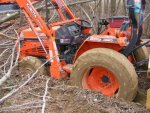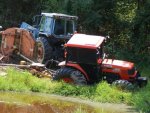L2501 HST 4wd
- Thread starter Bet
- Start date
RCW
Well-known member
Lifetime Member
Equipment
BX2360, FEL, MMM, BX2750D snowblower. 1953 Minneapolis Moline ZAU
If you don’t need it don’t use it.
If you have good traction, 4WD can put extra strain on the front drivetrain, especially in turns.
With that said, I leave mine in 4WD almost all winter, but it’s usually icy and slick.
Sent from my iPhone using Tapatalk
If you have good traction, 4WD can put extra strain on the front drivetrain, especially in turns.
With that said, I leave mine in 4WD almost all winter, but it’s usually icy and slick.
Sent from my iPhone using Tapatalk
BAP
Well-known member
Lifetime Member
Equipment
2012 Kubota 2920, 60MMM, FEL, BH65 48" Bush Hog, 60"Backblade, B2782B Snowblower
As long as you are not operating it on dry pavement you really aren’t going to hurt it. If you feel it binding in turns, then you should take it out because that means that there’s not enough give in the surface you are driving on.
MHO, leave it in 2wd until you need traction, then 4wd. Now if you are doing FEL work yeah 4wd might be a good idea. Other wise 2wd, your tractor will thank you, your tires will thank you, and your turf will thank you 
I only use 4wd when needed. I'd rather know I have extra traction available instead of going to far and not be able to get out.
This is one of my son's better moments. He said he stopped as soon as he knew he was stuck.
This is one of my son's better moments. He said he stopped as soon as he knew he was stuck.
Attachments
-
79 KB Views: 339
-
93.4 KB Views: 375
Newlyme
Active member
Lifetime Member
Equipment
M4900 w/loader, finish mower, tiller, auger, rake. BX24 w/loader, backhoe
North Idaho Wolfman
Moderator
Staff member
Lifetime Member
Equipment
L3450DT-GST, Woods FEL, B7100 HSD, FEL, 60" SB, 743 Bobcat with V2203, and more
I have left mine in 4wd since the day I got it... Well they day I started running it after fixing it.
But I live on all sand and not really anything hard packed, no little to no wear.
But I live on all sand and not really anything hard packed, no little to no wear.
This is one of my son's better moments. He said he stopped as soon as he knew he was stuck.
LMAO. It's a tractor, it will go through anything.
My machines stay in 2wd until 4wd is needed (That's Jeeps, trucks and tractors).
Generally speaking, using 4x4 only as needed is best.
On high-traction surfaces, like pavement, or rock, or concrete...the part-time 4x4 system of these tractors will bind upon turning and it puts a large amount of stress on the drivetrain. This is because as the front wheels turn, they are traveling at a different speed than the rear wheels (the inner wheels have a shorter distance to travel than the outer wheels). While there is a front and rear differential on each axle, there is no differential *between* the axles, and so no way to adjust for different speeds of the front and rear axles. When you turn in 4x4 on a highly tractive surface like pavement, your tires are forced to slip after the drivetrain binds. This is no different than the part-time 4x4 system found in many modern pickups. When you are on slippery surfaces such as grass, dirt, snow, etc...the slipping still happens...but it happens very easily with virtually no binding or stress on the drivetrain.
When your tires slip (and it usually is always the front tires to slip since they are smaller and gain less traction)...they wear. So although if you leave your machine in 4x4 at all times more than likely nothing will actually break...the tires will wear much faster.
I wish Kubota would offer a 4x4 indicator on the dashboard, but they don't on most models.
On high-traction surfaces, like pavement, or rock, or concrete...the part-time 4x4 system of these tractors will bind upon turning and it puts a large amount of stress on the drivetrain. This is because as the front wheels turn, they are traveling at a different speed than the rear wheels (the inner wheels have a shorter distance to travel than the outer wheels). While there is a front and rear differential on each axle, there is no differential *between* the axles, and so no way to adjust for different speeds of the front and rear axles. When you turn in 4x4 on a highly tractive surface like pavement, your tires are forced to slip after the drivetrain binds. This is no different than the part-time 4x4 system found in many modern pickups. When you are on slippery surfaces such as grass, dirt, snow, etc...the slipping still happens...but it happens very easily with virtually no binding or stress on the drivetrain.
When your tires slip (and it usually is always the front tires to slip since they are smaller and gain less traction)...they wear. So although if you leave your machine in 4x4 at all times more than likely nothing will actually break...the tires will wear much faster.
I wish Kubota would offer a 4x4 indicator on the dashboard, but they don't on most models.
It was sitting on the loader subframe and that was with the box scrape lifted all the way up.Bulldog, about the only thing to make it more fun would be if he had a belly mower on it!!
Of course he gets it honest. This is when I almost turned over in the pond.
Attachments
-
77.9 KB Views: 263
That will make you want to get some dry britches!!! How far did you have to go to get the Ford to anchor you?
Took my neighbor about 20 minutes to get there. I'm glad he got there when he did because it was still sinking.
I take it you fellows haven't seen the other thread, where the guy lost all braking power, because he was in 2WD and didn't have enough weight in the rear? There's more to 4WD than traction. Strangely, it also effects braking
Sent from my SM-N950U using Tapatalk
Sent from my SM-N950U using Tapatalk




